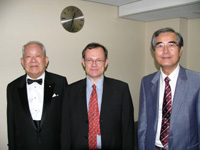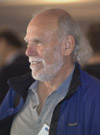 | | |  | Four TESLA Cavities Delivered to Fermilab

One of the four ILC cavities being measured at Fermilab before it is sent to Cornell University for chemical buffering. |
Four unprocessed TESLA cavities recently arrived at Fermilab for measurements and testing. The 9-cell, 1.3 Ghz cavities, manufactured by ACCEL in Germany, will be used to construct the first U.S. cryomodule for International Linear Collider R&D near the end of 2006. "We plan to use the four cavities from ACCEL and four other cavities to construct the first U.S. cryomodule," said Fermilab's Harry Carter. "Having the first cryomodule ready in the end of 2006 is actually quite fast because we are taking much of the work that was already done at DESY and building on it. If we did it from scratch, it would take significantly longer." One of the cavities has already been sent to Cornell University. After Fermilab finishes the measurement process in the next two weeks, the remaining three cavities will be sent to Cornell for buffered chemical polishing and vertical testing. After the chemical process at Cornell, the cavities will go to JLab for electropolishing and the installation of titanium helium vessels. "They will then come back to Fermilab as sealed cavities, where they will be stored until the horizontal test stand is ready next summer," Carter said. Fermilab and Argonne are currently building a facility where cavities for ILC R&D will eventually be processed and assembled. "Fermilab plans to send someone to Cornell to accompany the cavities and learn more about the chemical process," Carter said. "We hope to eventually do all of the processing here." Over the next four years, Fermilab plans to assemble one cryomodule a year, having four cryomodules installed in the ILCTA-NM (new muon) facility by 2009.
--Elizabeth Clements |  | | |  | Upcoming meetings, conferences, workshops
Nanobeams 2005
Kyoto, Japan, 17-21 October 2005
European GDE Meeting
Oxford, England, 24-25 October 2005
Damping Rings Meeting
CERN, Switzerland, 9-11 November 2005
ECFA ILC Workshop
Vienna, Austria, 14-17 November 2005
TESLA Technology Collaboration Meeting
Frascati, Italy, 5-6 December 2005
GDE Meeting
Frascati, Italy, 7-9 December 2005
2006 LCWS 2006
Bangalore, India, 9-15 March 2006 | 
Placing wafers on PCB for the CALICE (Calorimeter for Linear Collider Experiment) Collaboration. Learn more (PPT, 26M) about last week's CALICE Collaboration meeting at DESY.
| |  |  | | |  | Einstein, the Violin and the Neutrino

From left to right: Professor emeritus Masatoshi Koshiba, Professor Brian Foster and KEK Director General Yoji Totsuka. |
The year 2005 is "The World Year of Physics", commemorating the 100th anniversary of the publication of three great physics papers by Albert Einstein. Professor Brian Foster, European regional director of ILC GDE, has been trying hard to promote the link between physics and music. As a violinist who started his lessons at the age of 11, he loves Mozart, much as Einstein did. He and his teacher, Jack Liebeck, a young and talented violinist from the UK, have become close friends and are traveling around the globe, literally, to play together in a lecture celebrating, Einstein, music and Superstrings. Foster is also organising 27 or so gala concerts world-wide. In Japan, together with another talented young pianist Kotaro Fukuma, they were greeted by a Nobel laureate physicist Professor Masatoshi Koshiba. KEK hosted a joint lecture and concert titled "Tunes of Physics and Violin" on the 9th of October, where Koshiba talked about neutrinos, and Liebeck and Fukuma played Mozart, Brahms, Paert and Elgar.
Although Foster did not meet Koshiba while he was a member of the TASSO experiment at DESY in the 1970s and 80s, he did meet many of his students such as Professors Orito and Yamada. Yamada was the last director of INS, the Institute of Nuclear Study at University of Tokyo. The late professor Orito was one of the most important leaders for promoting the linear collider among Japanese physicists. "Making sure that everyone is working in the same direction is a big challenge", Foster speaks of his role in ILC GDE. "We have to make sure that the European Union is onboard, and that requires political activity. I was in Brussels last month to talk to the EU; we had a very positive meeting."
Read more
--Youhei Morita and Kaoruko Saeki
|  | | |  | | From physicsweb,
October 2005
A global role for physics
Forum: October 2005
As the World Year of Physics draws to a close, delegates from around the world are meeting in South Africa this month to discuss how science can improve the lives of people in developing nations. Katepalli Sreenivasan explains why physics has such a vital role to play
Read more
From Interactions.org,
14 October 2005
KEK pushes superconducting cavity to work at its theoretical limit
Team of accelerator physicists led by associate professor Kenji Saito, High Energy Accelerator Research Organization (KEK), successfully achieved 52.3 MV/m field gradient on Niobium superconducting accelerator cavity. This gradient is an equivalent to connecting 35 million AA battery cells in series into one meter.
Read more
| |  |  | | |  | Electron Source
As I have discussed the past couple of weeks, the baseline ILC design will be guided and flow from a set of overall requirements. These requirements began from the science goals or requirements that were then translated into technical requirements for an accelerator. With these requirements established, the choices for the different subsystems of the ILC are being determined as consistently as possible with the technical parameters. 
Barry Barish | In some cases, the requirements can be met with a technically sound and economical choice, while in other cases meeting the requirements might prove to be too difficult, require extensive R&D, be too costly, or perhaps suggest that some modifications be made in the requirements or other subsystems. The process of determining a complete consistent design that meets a challenging set of requirements is necessarily an iterative process. The design of the individual subsystems begins with the sources of particles, in this case electrons and positrons. For the ILC, producing electrons consistent with the requirements is the more straightforward. Therefore, I will begin with a brief summary of the electron source. Before Snowmass, we split working group 3 (WG3) into two working groups, where WG3a, led by M. Kuriki, J. Clarke, J. Sheppard and P. Piot, concentrated on the positron and electron sources and bunch compressors.
Read more --Barry Barish Director's Corner Archive |  | | |  | New ILC Graduate Students and Postdocs
The following graduate students and postdocs recently joined ILC groups:
Sergei Seletskiy, SLAC, Postdoc
Grigori Eremeev, Cornell, Graduate Student
Alexander Romanenko, Cornell, Graduate Student
Yasmina Fedala, Orsay, Graduate Student
Manqi Ruan, Orsay and Tsinghua, China, Graduate Student
Maria del Carmen Alabau Pons, Orsay and Valencia, Spain, Graduate Student
CÚcile Rimbault, Orsay, Postdoc
Olivier Dadoun, Orsay, Postdoc
Myriam Qureshi, Adams Institute at the University of Oxford, Graduate Student
John Dale, Adams Institute at the University of Oxford, Graduate Student
Lawrence Deacon, Adams Institute at Royal Holloway, University of London, Graduate Student
Sehwook Lee, Iowa State University, Graduate Student
Know somebody who is not listed here? Please send the names of new graduate students and postdocs to newsline@ilcgde.org.TESLA Collaboration/ GDE Meeting, 5-10 December 2005
Information about the TESLA Collaboration meeting and the next GDE meeting is now available online. The registration and hotel reservation deadlines are 5 November 2005. ILC Related Preprints
hep-ph/0510195 - Factorizable electroweak O(alpha) corrections for top quark pair production and decay at a linear e+e- collider, 14 Oct 2005 hep-ph/0510184 - Electroweak Corrections for the Study of the Higgs Potential at the LC, 14 Oct 2005 hep-ph/0510107 - Top and Higgs Flavor Changing Neutral Couplings in two Higgs Doublets Model, 8 Oct 2005
If you recently released a preprint related to the ILC, let us know! | |

